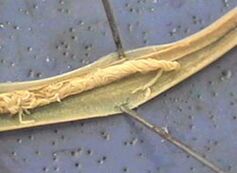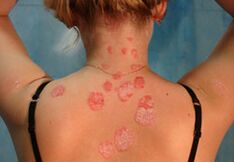Many people who lead a healthy lifestyle have health disorders due to the presence of parasites.Extraction of the body (proper nutrition, physical exercises, strengthening procedures) without eliminating the body from the parasites does not give a pronounced positive effect.According to the World Health Organization, poisons are located not only in the gastrointestinal tract, but also in the vital organs: brain, heart, lungs, liver, kidneys.Helminths in the processes of their lives distinguish special substances - toxins that are strong poisons and allergens.Simplest, fungi and helminths that are the mechanism of cause for many chronic diseases: cholecystitis, cholelithiasis, pancreatitis, colitis, diabetes mellitus, bronchial asthma, atopic dermatitis.

Chronic fatigue, irritability and anxiety, hyperactivity in children, anemia, fragile nails and hair, problems with problems, headaches, appetite disorders, decreased immunity - these can be the signals of the current disease.With a long stay of parasites in the human body, the immune system suffers a lot.In the process of constant struggle with foreign antibodies, it comes for exhaustion, that is, the development of secondary immunity.Parasitic disease leads to hypovitaminosis, impoverishment of microelements: potassium, copper, manganese, selenium, zinc, magnesium, silicon;Violation of hematopoiesis, hormonal failure, vascular permeability is violated, protection against body cancer suffers.
For millennia, humans, mostly plant foods, received antimicrobial, anti -masticistic and antiviral natural substances with it.A decrease in consumption of wild plants, fruits, berries, their vegetables and fruits, thermal and industrial treatment led to a decrease in unstable natural consumption and antibiotics.As a result, a person became easy prey for many microorganisms.The intensive development of the drug industry that produces antibiotics led to a decrease in immunity.
Determination of parasites

Parasites (from Greek parasites - an overlap, a parasites) - low plant and animal organisms living abroad or within another organism (owner) and eat at its expenses.The parasites were raised in the process of historical development of organisms from living forms freely.Adjusting them to certain conditions of life implies simplifying their organization, developing specific fixing organs, enhancing the development of genitals, breathing, which makes it possible to exist in an unbearable environment.Parasites include many helminths, fungi, viruses, protozoa, worms, crustaceans, spider formed, insects.Owners of parasites can be bacteria, simpler, plants, animals and humans.Parasites undergo a complex development cycle: sometimes they need a change of 2-3 owners whose body is intermediate (helminths pass the stages of larvae) or final (helminths become mature, invading).Parasites cause weakening and impoverishment of the host's body, cause a number of diseases.
Helminants can parasitize in all a person's tissues and organs, but the most common place of their localization is the nutritional tract.Bull and pig pigs, a wide tape are fixed to the upper intestine, also parasitizes ascaris.The dwarf's tabbell is mainly localized in the lower third of the small intestine, Vlasovs - in the large intestine, opistorchis - in the bile passages of the liver and pancreatic ducts, pinworms - in the lower parts and in all parts of the large intestine.Thus, the distribution of different types of helminths along the digestive tract in search of the most favorable living conditions provides them with individual survival, and creates conditions for the development of certain types in a person's body.
ClaSSIFICaTION
By distribution:
- Ubiquities - meet everywhere.
- Tropical - scattered in tropical climatic zones.
According to biological and epidemiological traits: geohelminths - a disease in which helminths first develop in the human body, and then in a non -living substrate, most often on Earth.Biohelminths is a disease in which a biological cycle of helminth development is necessarily occurring in the body of other living beings except one person.Distinguish among the last owners, in whose body helminths develop in the mature sexual as well as intermediate phase, where the parasite is in the larvae stage or its reproduction is not sexually.A person is most often the last host, less often - intermediate.Helminthiasis of the bond is a disease in which parasites are distinguished from the human body with mature or almost mature, as a result of which another person's infection is possible or re -infection.
Depending on the localization of the parasite in the body: educational - to live in the intestinal cavity and other cavities of a person (for example, ascarides, tapes) and tissues - living in tissues.

In the place of residence in the owner:
- Outer (mosquitoes, blinds, caterpillars, lice).
- Internal (Helminthiasis):
- Round worms (nematoda - ascarides, vlasov, pinworms, strungyloids);
- Flat worms:
- trematodes (plate - cat bickelter, skistosoma);
- Cestodes (ribbon worms - bull and pig pork, dwarf tabbell, wide tape, echinococcus).
- Bacteriosis (Staphylococcus, Streptococcus).
- Protose (Amoebas, Lamblia, Trichomonas, often owners of chlamydia virus and AIDS).
- Mycosis (fungal diseases) -for example, candida.
How the parasites fit
- a long life expectancy (helminths live in the body for years, and sometimes as much as the parasite owner lives);
- The ability to suppress or modify the immune response of the host body (an immunity is born, arises, conditions are created for the penetration of pathogenic agents from external, as well as to resurrect the internal focuses of the infection);
- Many types of helminths, entering the digestive tract, distinguish anti -enzymes, which saves them from death;The digestive process is disturbed, toxic-allergic reactions that are different in gravity appear: urticaria, bronchial asthma, atopic dermatitis;
- Stage of development (eggs, larvae, change of owners);
- egg ability for years to continue in the outside environment;
- Sexual reproduction in which genetic information is exchanging, and this is the highest phase of development, leading to an increase in the heterogeneous population, that is, the parasites become less tangible;
- Lack of immunoprophylaxis methods, as the immune response is weak and unstable;
- Widespread helminth, many habitats (water, soil, air, plants and animals).
How the parasites enter the body

You can be infected not only through dirty hands.Animal hair is a carrier of worms (ascaride), lamblia.Worm eggs that have fallen from wool remain for up to 6 months and through dust, toys, carpets, underwear and beds and hands fall into the food tract.The dog through wet breathing distributes eggs at a distance of 5 meters (cats - up to 3 meters).Dog fleas also tolerate worm eggs.Ascarid eggs enter the body through vegetables, fruits, berries, greens, dirty hands, and also spread to flies.And incorrectly cooked barbecue or home -made bar is the way of infection with trichinellosis;Poorly salty fish, caviar - opisthorchiasis and wide tape.
So there are some ways to access the body:
- alimentary (through infected food, water, dirty hands);
- contact house (through household items, members of the infected family, pets);
- Through blood hair insects;
- Active (in which the larvae penetrates the skin or mucous membranes during contact with the infected soil when residing in open reservoirs).
PREVENTION
Here are some rules to be followed to prevent parasites from penetrating the body:
- It is not recommended to drink water from natural resources and in an unknown area.
- You cannot eat unwashed vegetables and fruits.
- It is advisable to be careful of mosquitoes, ticks and other insects that receive blood that may be carriers of parasites.It is necessary to use special protection tools against them, and in places where there are many of them, to wear long -sleeved pants and shirts.
- Before a trip to some places, it is necessary to vaccinate from typhus, plague, tropical fever and other infectious diseases.Going to the places where the malaria mosquito is found, you need to get anti -Male tablets.Collecting on a long journey, where ticks can be, is important to vaccinate from tick -born encephalitis.
- Don't let children hug and kiss dogs, cats and other pets. Take care of the health of pets - take them black courses.
- Follow the rules of personal hygiene, maintain the cleanliness of the house.
- Performing periodic antiParasitic preventive courses for the whole family.
Children and parasitic invasions

The most affected by the effects of parasites are children.They are infected with different types of parasites through dirty hands, sand, soil and water.Sometimes a baby's infection can occur in intrauterine, as the simplest bacteria, viruses, candida and helminth larvae can penetrate the fetus through the blood flow placenta as well as during birth through the birth canal.Due to the expansion of their motor activity, at the age of 1.5-3 years old, children can become infected at home, on a walk, in kindergarten when contacting contaminated objects (street shoes, floors, ordinary areas), on the road (playing in sandboxes or on the ground), as well as in contact with animals or houses on the street).The high probability of invasions from the parasites is observed with inconsistency with the rules of hygiene (unwashed hands, eating unwashed vegetables and fruits, eating raw water from natural ponds and swimming in them).Only pinworms worm eggs and dwarfs are transmitted directly from person to person.Eggs of other baking helminths must necessarily enter the body of an intermediate host or a suitable environment - soil or water.At the age of 1.5-3, the infection rate of children with helminths can reach 80%.
More than 90% of all helminthic diseases in children are caused by intestinal nematodes that parasitize in the intestinal lumen (ascaris, pinworms), parasitization of nematodes in the intestinal wall or other organs (ankylostoma, a non -cinella, and the intestinal uctum) are less common.In children, undergoing elementary hygiene (imprors of meat or fish inadequately treated or thermically insufficient, vegetables and fruits, not filled by natural reservoirs), there are virtually no worms (trematoda) and cestoda helminths.
How can a baby get infected?
The infection is performed when the egg larvae enter the body.Eggs enter the environment with feces of infected humans and animals.They have microscopic dimensions, are highly resistant to different influences and can preserve vibrancy for a long time outside the body (on the ground, on the surface of objects or products, in flax folds, on the skin).Once they are in the baby's oral cavity, the worm eggs pass, partially destroying, through the acid, the aggressive environment of the stomach and activated in the intestine, where conditions for the development of adults from the eggs are more favorable.Preschoolers and preschoolers are particularly susceptible to helminthic invasions, as they still have imperfect obstacles of the gastrointestinal tract.
Measures for Prevention of Helminthiasis in Children: For all family members to reconcile with hygiene rules, try to prevent the child's close contact and personal belongings with pets;On the road it is important to ensure that the child does not choose different objects;prevent contact with animals;It is important to get into the child's personal hygiene skills (wash your hands with soap after the road and visit the toilet);It is advisable to periodically do wet cleaning at home, wash with soap toys, especially in the presence of pets, as well as toys brought from walking home;carpets vacuums, upholstered furniture and upholstered toys;Do not give the child unwashed vegetables and fruits, not enough meat and thermally raw fish, raw water from natural reservoirs.
Signs of helminthic occupation in children

Most often, a child should be thought of for helminthic occupation by indirect signs.The probability of helminthic occupation is very high if the child has symptoms such as: saliva, nausea, decreased appetite or increased pathological, cramping around the umbilicus or without certain localization, which appear regardless of food intake, stool disorder (diarrhea diarrhea, frequent constipation or dizziness,Pale of faint, exposed to eye painting, pity bureaus, adult, significant pie, brightly adult, sexy, sensitive, sensitive, sensitive, sensitive, evening, the evening adult,engaged ", grinding teeth, itching in the perineum. Often parasites lead to body allergy, skin reactions appear in the form of atopic dermatitis (as a rule, it is stubborn, which is difficult for symptomatic therapy). If worms are found in a child or in one of the family members, it is necessary to treat the whole family.Important to strengthen the hygienic measures, in particular, to simmer and iron on both sides bedding and personal underwear.
























